Landlord Consent to Sublease Form
When tenants want to let someone else rent part of a property that they themselves are renting, they need to get their landlord’s approval. The landlords need to sign a landlord consent to sublease form. FormsPal has this form available for free. In addition to the fully-editable template, you will also find a detailed step-by-step guide in accomplishing it below.
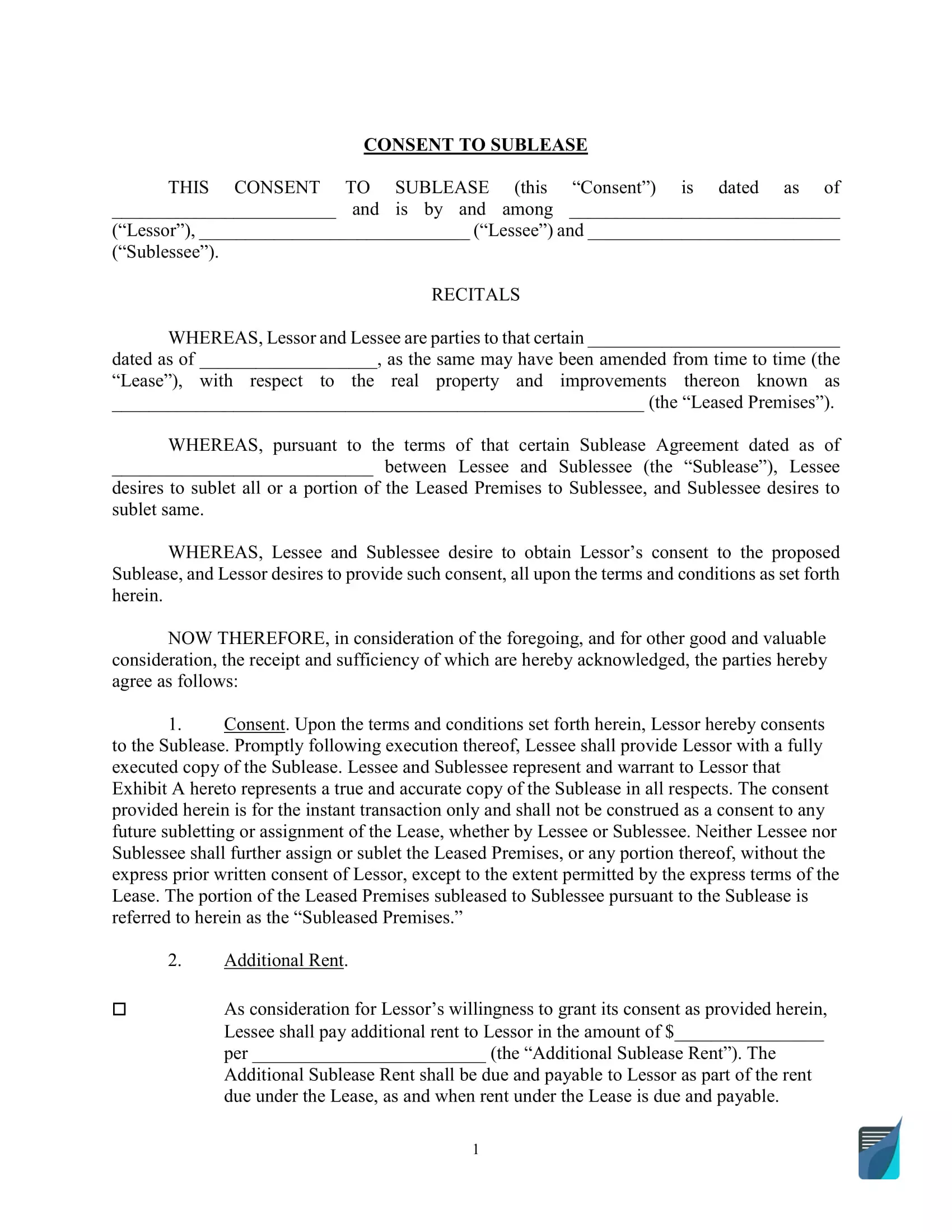
Build Your Document
Answer a few simple questions to make your document in minutes
Save and Print
Save progress and finish on any device, download and print anytime
Sign and Use
Your valid, lawyer-approved document is ready
When and Why to Use Permission to Sublet
Tenants need a sublease consent or permission to sublet form in cases when they want to earn extra income and maximize the use of a rented property’s space. In other cases, the tenant may need to leave the rented property before a rental agreement can be terminated. Subleasing allows the landlord to receive the sublease agreement another person apart from the original tenant.
Once a landlord signs a sublease consent form, the document gives the tenant permission to sublet part of or an entire leased property. The form transfers some of the tenant’s rights under the main lease to a third party. This document also ensures that all parties involved are aware of and satisfied with all terms and conditions of the arrangement.
Is it possible to sublease the property without the landlord’s consent?
In most cases, a written sublease consent is required from a landlord before a third party can be part of the main lease agreement. Most lease agreements include clauses where specifics of this arrangement are detailed. A tenant needs to check the main lease agreement before entering into any sublease arrangement. In cases when the main lease agreement does not provide specific clauses regarding subleasing, it is still recommended that the tenant ask the landlord’s permission.
How to Avoid Risks When Subleasing
Without a signed landlord consent to sublease form, a tenant who subleases a property may be accused of violating the terms of the main lease agreement. This may entail the eviction of the third party renting a subleased property.
A written sublease content provides clear details about the rights and obligations of the landlord, the tenant or sublandlord, and the sublessee.
In addition, a sublease agreement between the tenant or sublandlord and the sublessee, as well as a thorough process for reviewing sublease candidates, protects the landlord and the sublandlord from unscrupulous individuals who might turn out to be unreliable and untrustworthy sublessees.
Landlord Consent to Sublease Form Details
| Document Name | Landlord Consent to Sublease Form |
| Other Names | Consent to Sublease Letter, Permission to Sublet Letter |
| Avg. Time to Fill Out | 9 minutes |
| # of Fillable Fields | 29 |
| Available Formats | Adobe PDF |
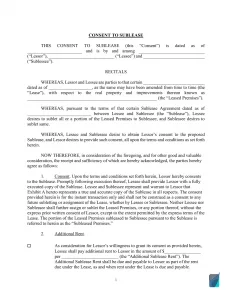
Filling out the Landlord Consent to Sublease Form
Detailed below are the steps to follow in accomplishing a landlord consent to sublease form.
Step 1 – Download the landlord consent to sublease template.
Choose the file format that is compatible with your computer.
- Landlord Consent to Sublease Form – Open Office Format (.odt)
- Landlord Consent to Sublease Form – Microsoft Office Format (.docx)
Step 2 – Fill out the execution date and the identities of the parties.

- Blank 1: First, write the date starting with the two-digit calendar day, name of the month, and calendar year when the landlord officially grants the tenant permission to sublease.
- Blank 2: Then, write down the name of the consenting landlord.
- Blank 3: Next, write down the name of the consenting landlord’s tenant.
- Blank 4: Lastly, write down the name of the sublessee.
Step 3 – Write down some basic facts regarding the main lease.

In the next part, supply information regarding the main lease agreement between the landlord and the tenant.
- Blank 1: First, write down the title of the prime lease or main contract that exists between the landlord and the tenant.
- Blank 2: Next, write down the date of execution of the prime lease.
- Blank 3: Then, write down the complete address where the leased premises is located (include the house number, street name, county/city, state, and zip code).
Step 4 – Write down some basic facts regarding the sublease.

Blank 1: In this part, write down the date of execution of the sublease.
Step 5 – Review the important clauses.
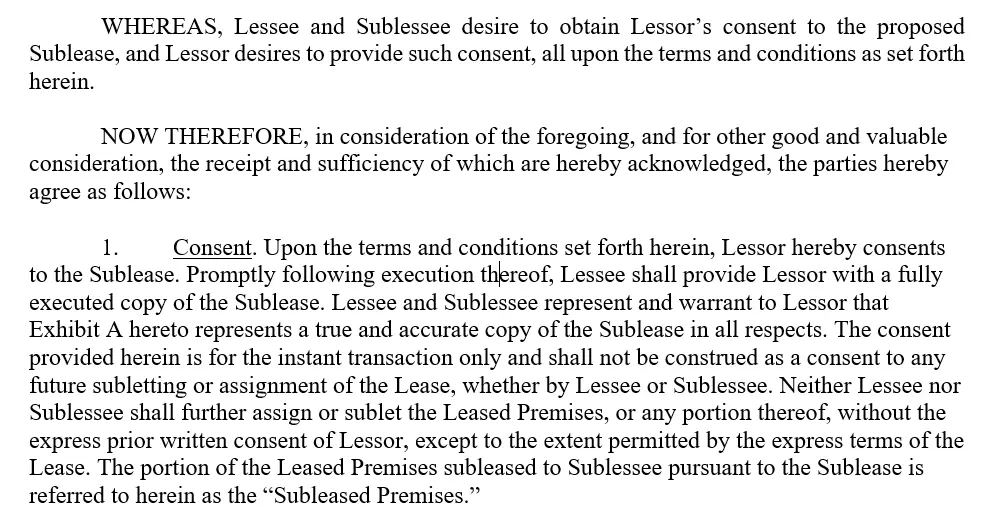
The tenant must review the provision stated in the above paragraphs. These are standard, but based on state laws, the conditions for consent may vary.
Step 6 – Complete the details about additional rent.
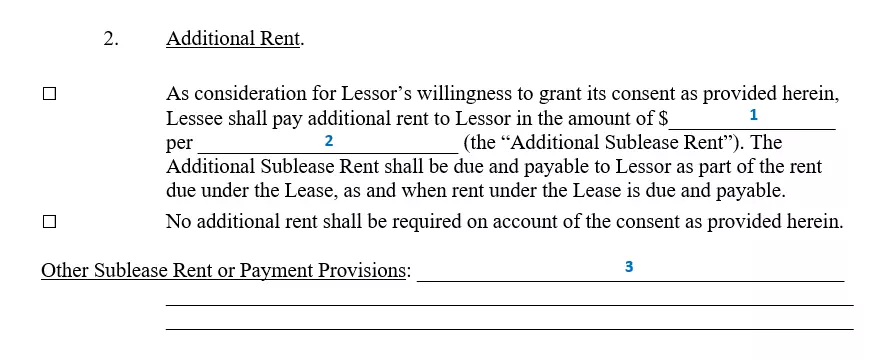
Mark the appropriate box that applies to the agreement with the landlord. Tick the first box if the landlord will charge additional rent for the sublease. Otherwise, tick the second box.
- Blank 1: If the first box is marked, write down the amount to be paid on top of the usual monthly rent.
- Blank 2: Write the frequency of payment (e.g. “month”).
If the second box is marked, no additional details are needed.
- Blank 3: Write down other details, if any, pertaining to the sublease rent on the lines provided.
Step 7 – Read the other standard provisions.
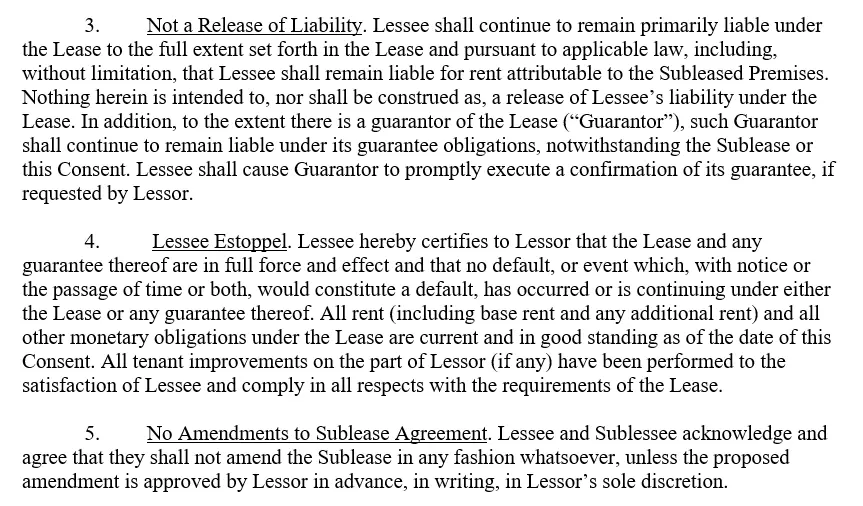
Sections four to five are standard and normally do not need to be revised. However, if either of the three parties request for changes, it is best to consult with a lawyer.
Step 8 – Add details about how to remit the sublessee’s rent.
Mark the appropriate box that applies to the agreement with the landlord regarding the remittance of the subleased property’s rent.

Tick the first box if the sublessee’s payment should be given directly to the landlord (either in cash or check). If the payment will pass through the sublandlord or original tenant, select the second box.
Step 9 – Select the consequences when the main lease ends.
Mark the appropriate box that applies to the agreement with the landlord. Should the prime or main lease end, the landlord and the sublessee may or may not continue the rental.

Choose the first box if the sublease will end when the main lease ends. If the landlord is open to negotiation so the sublessee may continue renting the premises, select the second box.
Step 10 – Go through the additional terms.

Section eight explains that consent is legally binding. Aside from this, any changes must undergo a proper process. This part is static and is normally kept as is.
Step 11 – Let all the parties sign the form.
In this final step, write down the details of the landlord, the lessee, and the sublessee.
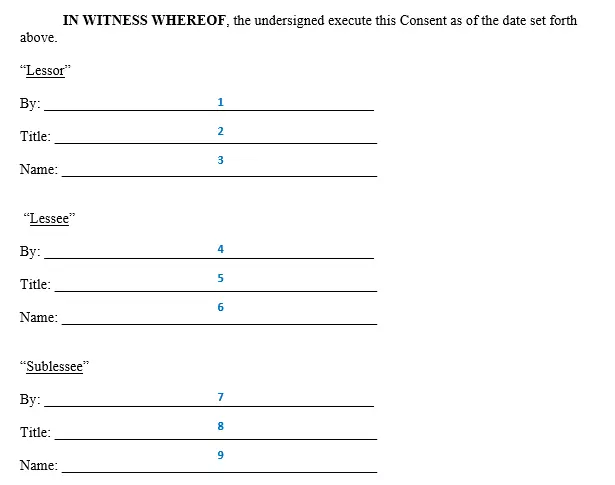
- Blank 1: Signature of the lessor or landlord.
- Blank 2: Position of the lessor (if he or she is representing a company)
- Blank 3: Full name of the lessor
- Blank 4: Signature of the lessee or prime lease tenant
- Blank 5: Position of the tenant (if applicable)
- Blank 6: Full name of the tenant.
- Blank 7: Signature of the sublessee or third-party renter.
- Blank 8: Position of the sublessee (if he or she is a company representative)
- Blank 9: Full name of the sublessee
Whether you are the primary tenant or the sublessee, it is important to secure the landlord’s consent before proceeding with the new rental arrangement. Most state laws require this form, so it’s best to keep all parties well informed. You may download FormsPal’s free Consent to Sublease form, so you won’t need to write one from scratch.
